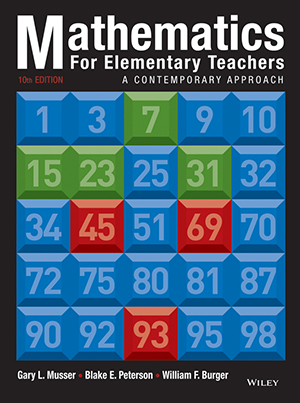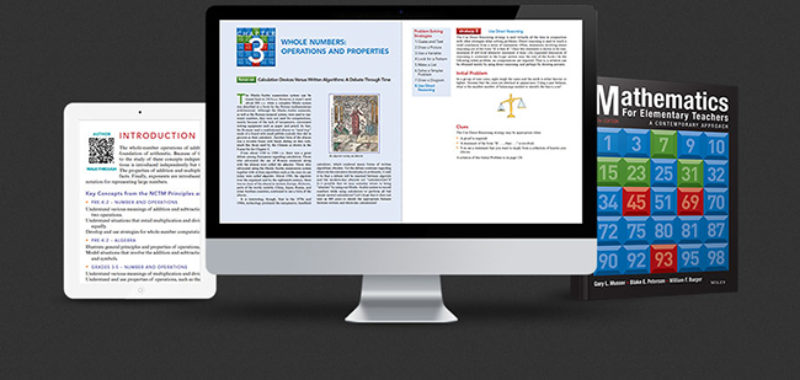
Mathematics for Elementary Teachers: A Contemporary Approach, 10th Edition
By Gary L. Musser, Blake E. Peterson, William F. Burger
The 10th Edition of Musser, Burger, and Peterson’s best-selling textbook focuses on one primary goal: helping students develop a true understanding of central concepts using solid mathematical content in an accessible and appealing format. The components in this complete learning program—from the textbook and the eManipulative activities to the online problem-solving tools and the resource-rich website—work in harmony to help achieve this goal.
This edition can also be accompanied with WileyPLUS, a research-based, online teaching and learning environment that integrates the entire digital textbook with the most effective resources to fit every learning style.
Schedule a Demo Sign Up for a Test Drive Adopt WileyPLUSWant to learn more about WileyPLUS? Click Here
Problem-Solving Emphasis
This text features more problems (over 3,000!), worked examples, and problem-solving strategies than any text of its kind.

Integrated Technology
Technology and content are integrated throughout the text in a meaningful way. The technology includes WileyPLUS, activities from the expanded eManipulative activities, spreadsheet activities, Geometer’s Sketchpad activities, and calculator activities using a graphics calculator.
Common Core and NCTM Standards
Both are referenced throughout in the margin and reviewed at the beginning of each chapter, giving future teachers a comprehensive understanding of the standards they will be responsible for as well as the skills that their students will be tested on.
- Instructor’s Resource Manual contains chapter-by-chapter discussions of the text material, student “expectations” (objectives) for each chapter, answers for all Part B exercises and problems, and answers for all of the even-numbered problems in the Problem-Solving Guide.
- Computerized Test/Print Test Bank
- WileyPLUS
Instructor Resources
- Student Activity Manual with Discussion Questions for the Classroom. The activity manual is designed to enhance student learning as well as to begin to model effective classroom practices.
- The ETA Cuisenaire® Physical Manipulative Kit is a generous assortment of manipulatives that has been created to accompany the text as well as the Student Activity Manual.
- The Student Hints and Solutions Manual contains hints and solutions to all of the Part A problems.
- eManipulatives
- Guide to Problem Solving
- Geometer’s Sketchpad and Spreadsheet Activities
- WileyPLUS
Student Resources

Garry L. Musser is Professor Emeritus from Oregon State University. He earned both his B.S. in Mathematics Education in 1961 and his M.S. in Mathematics in 1963 at the University of Michigan and his Ph.D. in Mathematics (Radical Theory) in 1970 at the University of Miami in Florida. He taught at the junior and senior high, junior college, college, and university levels for more than 30 years. He spent his final 24 years teaching prospective teachers in the Department of Mathematics at Oregon State University. While at OSU, Dr. Musser developed the mathematics component of the elementary teacher program. Soon after Professor William F. Burger joined the OSU Department of Mathematics in a similar capacity, the two of them began to write the first edition of this book. Professor Burger passed away during the preparation of the second edition, and Professor Blake E. Peterson was hired at OSU as his replacement. Professor Peterson joined Professor Musser as a coauthor beginning with the fifth edition. Professor Musser has published 40 papers in many journals, including the Pacific Journal of Mathematics, Canadian Journal of Mathematics, The Mathematics Association of America Monthly, the NCTM’s The Mathematics Teacher, the NCTM’s The Arithmetic Teacher, School Science and Mathematics, The Oregon Mathematics Teacher, and The Computing Teacher. In addition, he is a coauthor of two other college mathematics books: College Geometry—A Problem-Solving Approach with Applications (2008) and A Mathematical View of Our World (2007). He also coauthored the K–8 series Mathematics in Action. He has given more than 65 invited lectures/workshops at a variety of conferences, including NCTM and MAA conferences, and was awarded 15 federal, state, and local grants to improve the teaching of mathematics. While Professor Musser was at OSU, he was awarded the university’s prestigious College of Science Carter Award for Teaching. He is currently living in sunny Las Vegas, where he continues to write, ponder the mysteries of the stock market, enjoy living with his wife, and his faithful yellow lab, Zoey.

Blake E. Peterson is currently a Professor in the Department of Mathematics Education at Brigham Young University. He was born and raised in Logan, Utah, where he graduated from Logan High School. Before completing his B.A. in secondary mathematics education at Utah State University, he spent two years in Japan as a missionary for The Church of Jesus Christ of Latter Day Saints. After graduation, he took his new wife, Shauna, to southern California, where he taught and coached at Chino High School for two years. In 1988, he began graduate school at Washington State University, where he later completed a M.S. and Ph.D. in pure mathematics. After completing his Ph.D., Dr. Peterson was hired as a mathematics educator in the Department of Mathematics at Oregon State University in Corvallis, Oregon, where he taught for three years. It was at OSU that he met Gary Musser. He has since moved his wife and four children to Provo, Utah, to assume his position at Brigham Young University where he is currently a full professor. As a professor, his first love is teaching, for which he has received a College Teaching Award in the College of Physical and Mathematical Science. Dr. Peterson has published papers in Rocky Mountain Mathematics Journal, The American Mathematical Monthly, The Mathematical Gazette, Mathematics Magazine, The New England Mathematics Journal, The Journal of Mathematics Teacher Education, and The Journal for Research in Mathematics Education as well as chapters in several books. He has also published in NCTM’s Mathematics Teacher, and Mathematics Teaching in the Middle School. After studying mathematics student teachers at a Japanese junior high school, he implemented some elements he observed into the student teaching structure at BYU, which is now his research focus. In addition to teaching, research, and writing, Dr. Peterson has done consulting for the College Board, founded the Utah Association of Mathematics Teacher Educators, has been the chair of the editorial panel for the Mathematics Teacher, and is the associate chair of the department of mathematics education at BYU. Aside from his academic interests, Dr. Peterson enjoys spending time with his family, fulfilling his church responsibilities, playing basketball, mountain biking, water skiing, and working in the yard.
Chapter 1: Introduction to Problem Solving
Chapter 2: Sets, Whole Numbers, and Numeration
Chapter 3: Whole Numbers: Operations and Properties
Chapter 4: Whole Number Computation: Mental, Electronic, and Written
Chapter 5: Number Theory
Chapter 6: Fractions
Chapter 7: Decimals, Ratio, Proportion, and Percent
Chapter 8: Integers
Chapter 9: Rational Numbers, Real Numbers, and Algebra
Chapter 10: Statistics
Chapter 11: Probability
Chapter 12: Geometric Shapes
Chapter 13: Measurement
Chapter 14: Geometry Using Triangle Congruence and Similarity
Chapter 15: Geometry Using Coordinates
Chapter 16: Geometry Using Transformations
Epilogue: An Eclectic Approach to Geometry
Topic 1: Elementary Logic
Topic 2: Clock Arithmetic: A Mathematical System
Answers to Exercise/Problem Sets-Part A, Chapter Reviews, Chapter Tests, and Topics Section
Index

